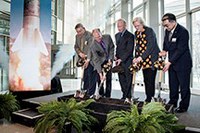Purdue's Zucrow expansion highlighted during celebration
- https://engineering.purdue.edu/Zucrow/news/2016-02-22
- Purdue's Zucrow expansion highlighted during celebration
- 2016-02-22T00:00:00-04:56
- 2016-02-22T23:59:59-04:56
- WEST LAFAYETTE, Ind. - Purdue University highlighted the expansion of facilities and research at its Maurice J. Zucrow Laboratories, the nation's largest university propulsion laboratory, during a Monday (Feb. 22) celebration in the Kurz Atrium of the Neil Armstrong Hall of Engineering.
| Event Date: | February 22, 2016 |
|---|---|
| Time: | All day |
| Location: | |
| Contact Name: | |
| Contact Phone: | |
| Contact Email: | |
| Priority: | Yes or No |
| School or Program: | |
| College Calendar: | [] |
| Add event to calendar: |
|
The event, “Fueled for Takeoff!” included remarks by Purdue President Mitch Daniels and Leah Jamieson, the John A. Edwardson Dean of Engineering.
The work is part of Purdue Moves, a range of initiatives designed to broaden Purdue's global impact and enhance educational opportunities for its students. One of the 10 tenets to Purdue Moves is to expand the College of Engineering.
Zucrow houses a variety of rocket and turbine-engine research. It is located in the 980-acre Purdue Research Park Aerospace District. The district is designed to support opportunities among Purdue and aerospace and aviation companies that wish to collaborate with Purdue on research projects or that want to build research and development facilities near Purdue. Rolls-Royce is the first such company committed to moving into a 40,000-square-foot research facility in the district. The site has already been named an Indiana Certified Technology Park by the Indiana Economic Development Corporation.
"Purdue is playing a major role in the development of next-generation jet engines," Jamieson said. "And in that effort, we are not only furthering the capabilities of industry, but of our graduates as well."
Purdue officials wielded gilded shovels in a simulated groundbreaking, including the original spade used by Maurice Zucrow in 1965 to break ground on the current high-pressure lab.
The expansion will include five new test cells in addition to the two already in place and will support laser-based measurements in a building to be constructed adjacent to Zucrow's high-pressure lab.
Developed as part of NASA's Apollo program, the high-pressure lab houses research sponsored by aerospace companies, NASA, the U.S. Air Force and other agencies. Industry collaborators have included Rolls-Royce, GE and Siemens.
The new, one-floor, 9,600-square-foot facility will cost $8.2 million. Construction began in January and will take about a year to complete. Much of the cost - $5 million – is coming from Lilly Endowment Inc. as part of a $40 million grant. Announced in 2015, the grant is the largest cash donation in Purdue's history.
The project will feature renovations to the current high-pressure lab and additional office space for growing the number of faculty and students. This includes 5,000 square feet for offices and a control room.
Another key upgrade is a new air heater that heats air to as high as 1,500 degrees Fahrenheit at a pressure of up to 850 pounds per square inch. The heater is critical to developing better jet engines because it will allow experiments to operate under higher temperatures and pressures than currently possible.
Zucrow is jointly operated by the university's School of Mechanical Engineering and the School of Aeronautics and Astronautics. It is a complex of six facilities founded in 1946 on a site west of campus. Over its nearly 70-year history, it has produced more than 1,000 graduates, including several who later became NASA astronauts. The labs specialize in rockets and gas-turbine engines, with faculty and students performing a wide range of propulsion-related research. More than 90 graduate students are working in the labs, which have annual research expenditures exceeding $9 million.
Propulsion research at Zucrow is led by Stephen D. Heister, Zucrow director and the Raisbeck Engineering Distinguished Professor for Engineering and Technology Integration; Robert Lucht, the Ralph and Bettye Bailey Professor of Combustion in Mechanical Engineering; William Anderson, a professor of aeronautics and astronautics; Nicole Key, an associate professor of mechanical engineering, and aeronautics and astronautics; Steven Son, a professor of mechanical engineering, and aeronautics and astronautics; and Timothée Pourpoint, associate professor of aeronautics and astronautics. He leads an interdisciplinary team of students and faculty at Purdue in designing and building three types of torches that will be central to Indiana’s bicentennial relay later this year. Much of the work is being performed at Zucrow.
Writer: Emil Venere, 765-494-4709, venere@purdue.edu
Sources: Leah Jamieson, 765-494-5346, lhj@purdue.edu
Stephen D. Heister, 765 49-45126, heister@purdue.edu

